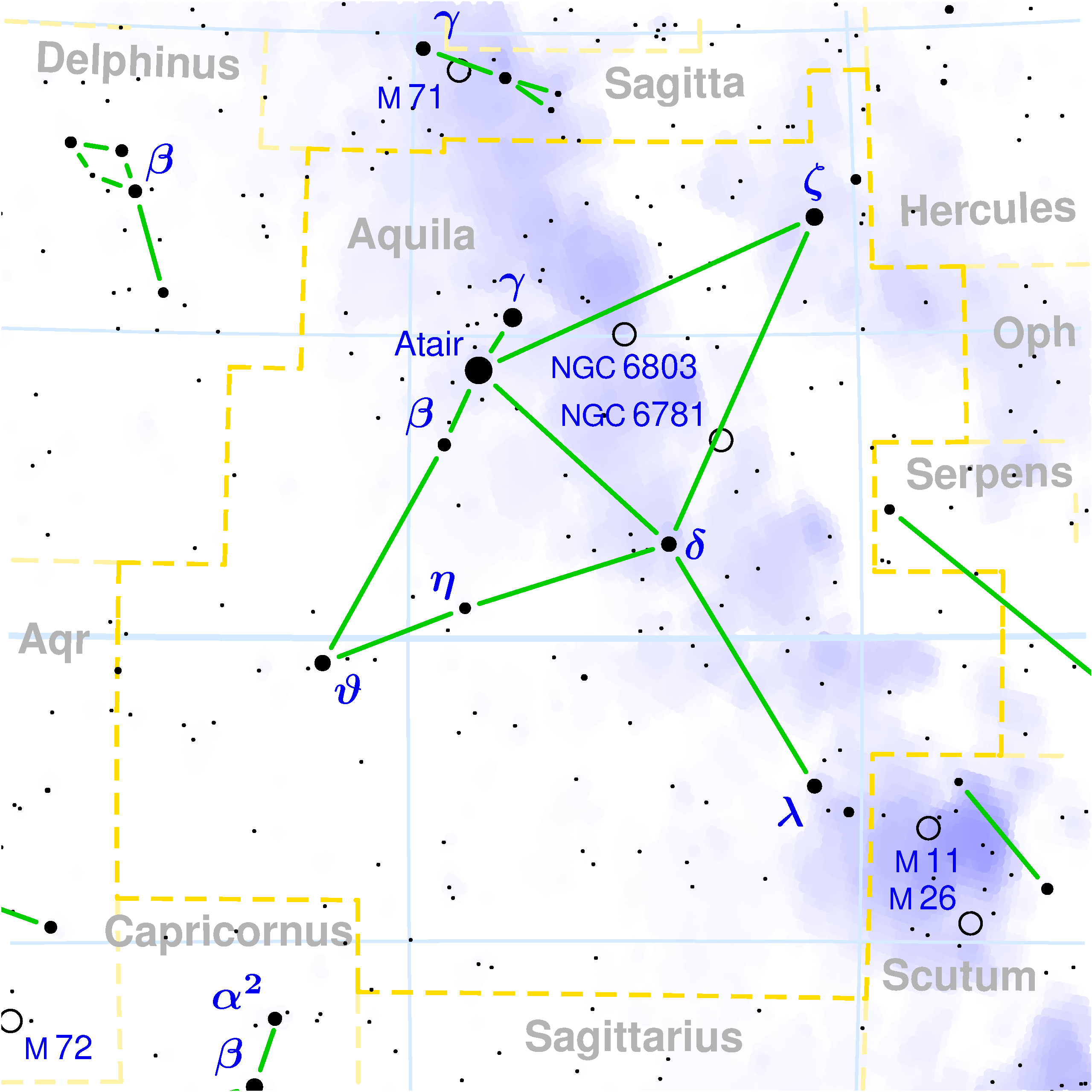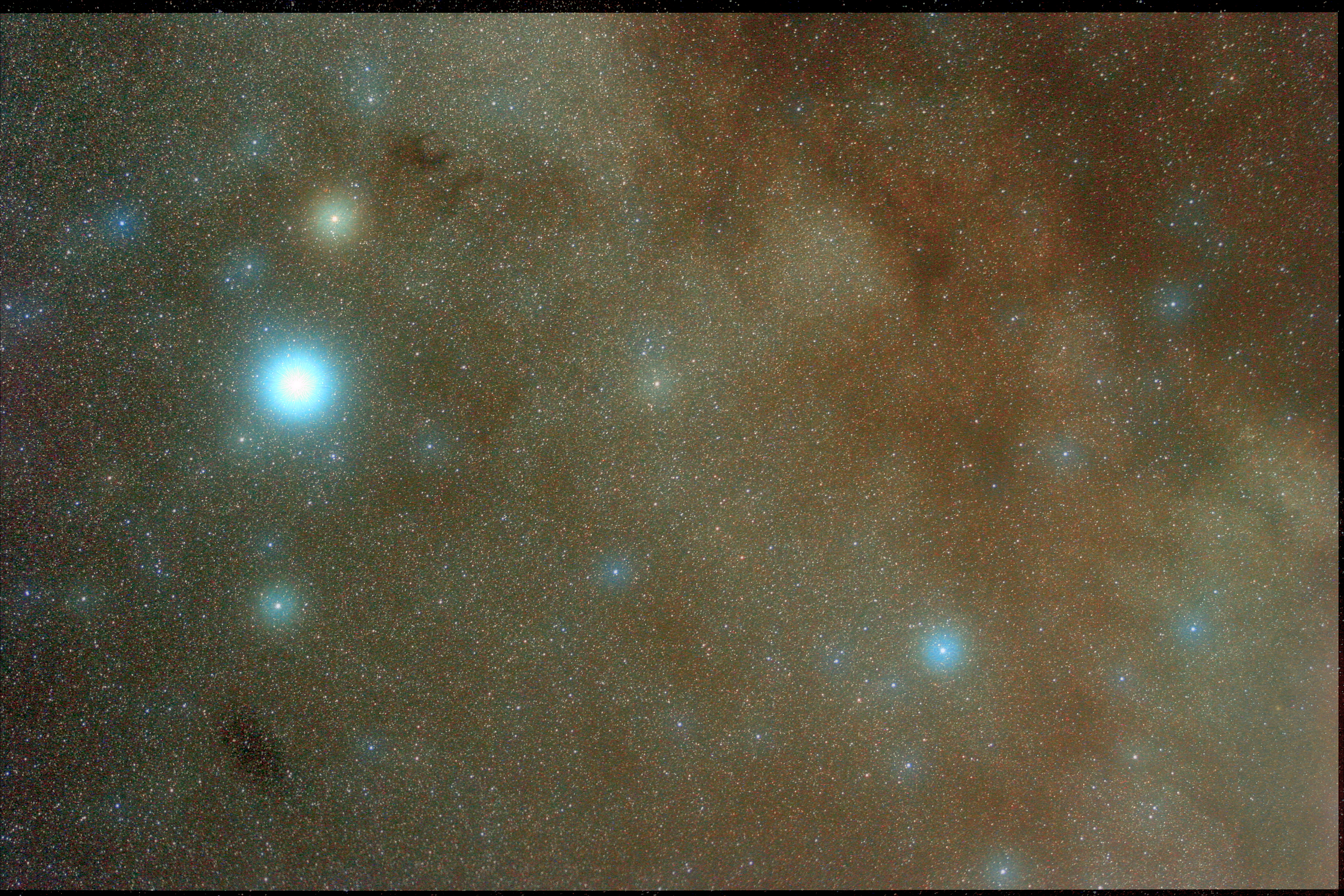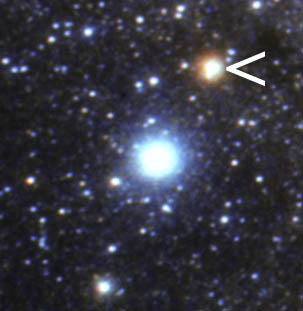|
List Of Stars In Aquila
This is the list of 143 notable stars in the constellation Aquila, sorted by decreasing brightness. See also *List of stars by constellation All stars but one can be associated with an IAU constellation. IAU constellations are areas of the sky. Although there are only 88 IAU constellations, the sky is actually divided into 89 irregularly shaped boxes as the constellation Serpens is spli ... References * * * * * * * * * {{DEFAULTSORT:List of stars in Aquila *List Aquila ... [...More Info...] [...Related Items...] OR: [Wikipedia] [Google] [Baidu] |
Star
A star is an astronomical object comprising a luminous spheroid of plasma (physics), plasma held together by its gravity. The List of nearest stars and brown dwarfs, nearest star to Earth is the Sun. Many other stars are visible to the naked eye at night sky, night, but their immense distances from Earth make them appear as fixed stars, fixed points of light. The most prominent stars have been categorised into constellations and asterism (astronomy), asterisms, and many of the brightest stars have proper names. Astronomers have assembled star catalogues that identify the known stars and provide standardized stellar designations. The observable universe contains an estimated to stars. Only about 4,000 of these stars are visible to the naked eye, all within the Milky Way galaxy. A star's life star formation, begins with the gravitational collapse of a gaseous nebula of material composed primarily of hydrogen, along with helium and trace amounts of heavier elements. Its stellar ... [...More Info...] [...Related Items...] OR: [Wikipedia] [Google] [Baidu] |
Altair
Altair is the brightest star in the constellation of Aquila and the twelfth-brightest star in the night sky. It has the Bayer designation Alpha Aquilae, which is Latinised from α Aquilae and abbreviated Alpha Aql or α Aql. Altair is an A-type main-sequence star with an apparent visual magnitude of 0.77 and is one of the vertices of the Summer Triangle asterism; the other two vertices are marked by Deneb and Vega. It is located at a distance of from the Sun. Altair is currently in the G-cloud—a nearby interstellar cloud, an accumulation of gas and dust. Altair rotates rapidly, with a velocity at the equator of approximately 286 km/s.From values of ''v'' sin ''i'' and ''i'' in the second column of Table 1, Monnier et al. 2007. This is a significant fraction of the star's estimated breakup speed of 400 km/s. A study with the Palomar Testbed Interferometer revealed that Altair is not spherical, but is flattened at the poles due to i ... [...More Info...] [...Related Items...] OR: [Wikipedia] [Google] [Baidu] |
Cepheid Variable
A Cepheid variable () is a type of star that pulsates radially, varying in both diameter and temperature and producing changes in brightness with a well-defined stable period and amplitude. A strong direct relationship between a Cepheid variable's luminosity and pulsation period established Cepheids as important indicators of cosmic benchmarks for scaling galactic and extragalactic distances. This robust characteristic of classical Cepheids was discovered in 1908 by Henrietta Swan Leavitt after studying thousands of variable stars in the Magellanic Clouds. This discovery allows one to know the true luminosity of a Cepheid by simply observing its pulsation period. This in turn allows one to determine the distance to the star, by comparing its known luminosity to its observed brightness. The term ''Cepheid'' originates from Delta Cephei in the constellation Cepheus, identified by John Goodricke in 1784, the first of its type to be so identified. The mechanics of stellar pu ... [...More Info...] [...Related Items...] OR: [Wikipedia] [Google] [Baidu] |
Eta Aquilae
Eta Aquilae (η Aql, η Aquilae) is the Bayer designation for a multiple star in the equatorial constellation of Aquila, the eagle. It was once part of the former constellation Antinous. On average, this star has an apparent visual magnitude of 3.87, making it one of the brighter members of Aquila. Based upon parallax measurements made during the Hipparcos mission, this star is located at a distance of roughly , although the parallax estimate has a 44% margin of error. System The η Aquilae system contains at least two stars, probably three. The primary star η Aql A is by far the brightest and dominates the spectrum. An ultraviolet excess in the spectral energy distribution suggest the presence of a faint hot companion, η Aql B, which has been given a spectral type of B8.9 V. The fractional spectral type is an artefact of the mathematics used to model the spectrum, not an indication of any specific spectral features that would be intermediate between B8 and B9. Radial ... [...More Info...] [...Related Items...] OR: [Wikipedia] [Google] [Baidu] |
Beta Aquilae
Beta Aquilae, Latinized from β Aquilae, is a triple star system in the equatorial constellation of Aquila. It is visible to the naked eye as a point-like source with an apparent visual magnitude of 3.87. Based on parallax measurements obtained during the Hipparcos mission, it is located at a distance of approximately 44.7 light-years from the Sun. It is drifting closer to the Sun with a radial velocity of −40 km/s. Its two components are designated Beta Aquilae A (formally named Alshain , the traditional name for the system) and B. Nomenclature ''β Aquilae'' (Latinised to ''Beta Aquilae'') is the system's Bayer designation. The designations of the two components as ''Beta Aquilae A'' and ''B'' derive from the convention used by the Washington Multiplicity Catalog (WMC) for multiple star systems, and adopted by the International Astronomical Union (IAU). The system bore the traditional name ''Alshain'' derived from the Perso-Arabic term الشاهين, ' ... [...More Info...] [...Related Items...] OR: [Wikipedia] [Google] [Baidu] |
Lambda Aquilae
Lambda Aquilae, Latinized from λ Aquilae, is a star in the constellation Aquila. It has the traditional name Al Thalimain , which it shares with ι Aquilae. The name is derived from the Arabic الظلیمين ''al-ẓalīmayn'' "the two ostriches". Lambda Aquilae is more precisely ''Al Thalimain Prior''. It has an apparent visual magnitude of 3.43, which is bright enough to be seen with the naked eye. Parallax measurements place it at a distance of about from Earth. Properties Lambda Aquilae is a main sequence star with a stellar classification of B9Vn, which means that, like the Sun, it is generating energy at its core through the nuclear fusion of hydrogen. It is more massive than the Sun, with about three times its mass, and radiates about 55 times the Sun's luminosity from its outer envelope at a higher effective temperature of 11,780 K. This temperature gives Lambda Aquilae the blue-white hue that is a characteristic of B-type stars. Lambda Aquilae was one ... [...More Info...] [...Related Items...] OR: [Wikipedia] [Google] [Baidu] |
Binary Star
A binary star is a system of two stars that are gravitationally bound to and in orbit around each other. Binary stars in the night sky that are seen as a single object to the naked eye are often resolved using a telescope as separate stars, in which case they are called ''visual binaries''. Many visual binaries have long orbital periods of several centuries or millennia and therefore have orbits which are uncertain or poorly known. They may also be detected by indirect techniques, such as spectroscopy (''spectroscopic binaries'') or astrometry (''astrometric binaries''). If a binary star happens to orbit in a plane along our line of sight, its components will eclipse and transit each other; these pairs are called ''eclipsing binaries'', or, together with other binaries that change brightness as they orbit, ''photometric binaries''. If components in binary star systems are close enough they can gravitationally distort their mutual outer stellar atmospheres. In some cases, thes ... [...More Info...] [...Related Items...] OR: [Wikipedia] [Google] [Baidu] |
Delta Aquilae
Delta Aquilae, Latinized from δ Aquilae, is a binary star system in the equatorial constellation of Aquila. It has an apparent visual magnitude of 3.4 and, based upon parallax measurements, is located at a distance of about from Earth. It is drifting closer with a radial velocity of −30 km/s. The system is predicted to come to within of the Sun in around 335,000 years. Properties The binary nature of this system was first reported by H. L. Alden at Yale Observatory in 1936. It is an astrometric binary where the two components orbit each other with a period of 3.422 years and an eccentricity (ovalness) of about 0.36. This is a type of binary star system where the presence of the secondary component is revealed by its gravitational perturbation of the primary. The individual components have not been resolved with a telescope. The primary member, designated component Aa, is an aging subgiant star with a stellar classification of F0 IV, where the ... [...More Info...] [...Related Items...] OR: [Wikipedia] [Google] [Baidu] |
Spectroscopic Binary
A binary star is a system of two star, stars that are gravity, gravitationally bound to and in orbit around each other. Binary stars in the night sky that are seen as a single object to the naked eye are often resolved using a telescope as separate stars, in which case they are called ''visual binaries''. Many visual binaries have long orbital periods of several centuries or millennia and therefore have orbits which are uncertain or poorly known. They may also be detected by indirect techniques, such as spectroscopy (''spectroscopic binaries'') or astrometry (''astrometric binaries''). If a binary star happens to orbit in a plane along our line of sight, its components will eclipse and transit (astronomy), transit each other; these pairs are called ''eclipsing binaries'', or, together with other binaries that change brightness as they orbit, ''photometric binaries''. If components in binary star systems are close enough they can gravitationally distort their mutual outer stella ... [...More Info...] [...Related Items...] OR: [Wikipedia] [Google] [Baidu] |
Theta Aquilae
Theta Aquilae (θ Aql, θ Aquilae) is a binary star in the constellation Aquila. The combined apparent visual magnitude of the pair is 3.26, making it the fourth-brightest member of the constellation. In Chinese, it has the traditional name Tseen Foo , from the Chinese 天 桴 (Mandarin pronunciation ''tiānfú''), which could mean "heavenly raft" or "heavenly ridgepole"; it might also mean "heavenly drumsticks", with Altair, Beta Aquilae and Gamma Aquilae being the drum. This distance to this star can be determined through the parallax technique, yielding an estimate of roughly from Earth. Properties Theta Aquilae is a double-lined spectroscopic binary, which indicates that the individual components have not been viewed through a telescope; instead, what can be viewed is their combined spectrum with the individual absorption line features shifting back and forth over the course of an orbit because of the Doppler effect. Their orbit has a period of 17.1 days with ... [...More Info...] [...Related Items...] OR: [Wikipedia] [Google] [Baidu] |
Zeta Aquilae
Zeta Aquilae, or ζ Aquilae, is a binary star system in the equatorial constellation of Aquila. It is readily visible with the naked eye, being of the third magnitude. Based on parallax measurements obtained during the Hipparcos mission, it is approximately distant from the Sun. It is a candidate member of the TW Hydrae association of co-moving stars. Zeta Aquilae's two components can be designated Zeta Aquilae A (officially named Okab , the traditional name for the system) and B. Zeta Aquilae has a number of companions listed and together they are designated WDS J19054+1352. As the primary star of this group, Zeta Aquilae also bears the designation WDS J19054+1352A. The companions are then designated WDS J19054+1352B, C, D and E. Nomenclature ''ζ Aquilae'', Latinised to ''Zeta Aquilae'', is the binary's Bayer designation. The designations of the two components as ''Zeta Aquilae A'' and ''B'' derive from the convention used by the Washington Multipli ... [...More Info...] [...Related Items...] OR: [Wikipedia] [Google] [Baidu] |
Gamma Aquilae
Gamma Aquilae, Latinized from γ Aquilae, and formally known as Tarazed , is a star in the constellation of Aquila. It has an apparent visual magnitude of 2.712, making it readily visible to the naked eye at night. Parallax measurements place it at a distance of from the Sun. Properties Gamma Aquilae is a relatively young star with an age of about 270 million years. Nevertheless, it has reached a stage of its evolution where it has consumed the hydrogen at its core and expanded into what is termed a bright giant star, with a stellar classification of K3 II. The star is now burning helium into carbon in its core. After it has finished generating energy through nuclear fusion, Gamma Aquilae will become a white dwarf. The star has an estimated 3.5 times the mass of the Sun and has expanded to 92 times the Sun's radius. It is radiating over times the luminosity of the Sun. An effective temperature of in its outer envelope gives it the orange hue typical of K ... [...More Info...] [...Related Items...] OR: [Wikipedia] [Google] [Baidu] |






